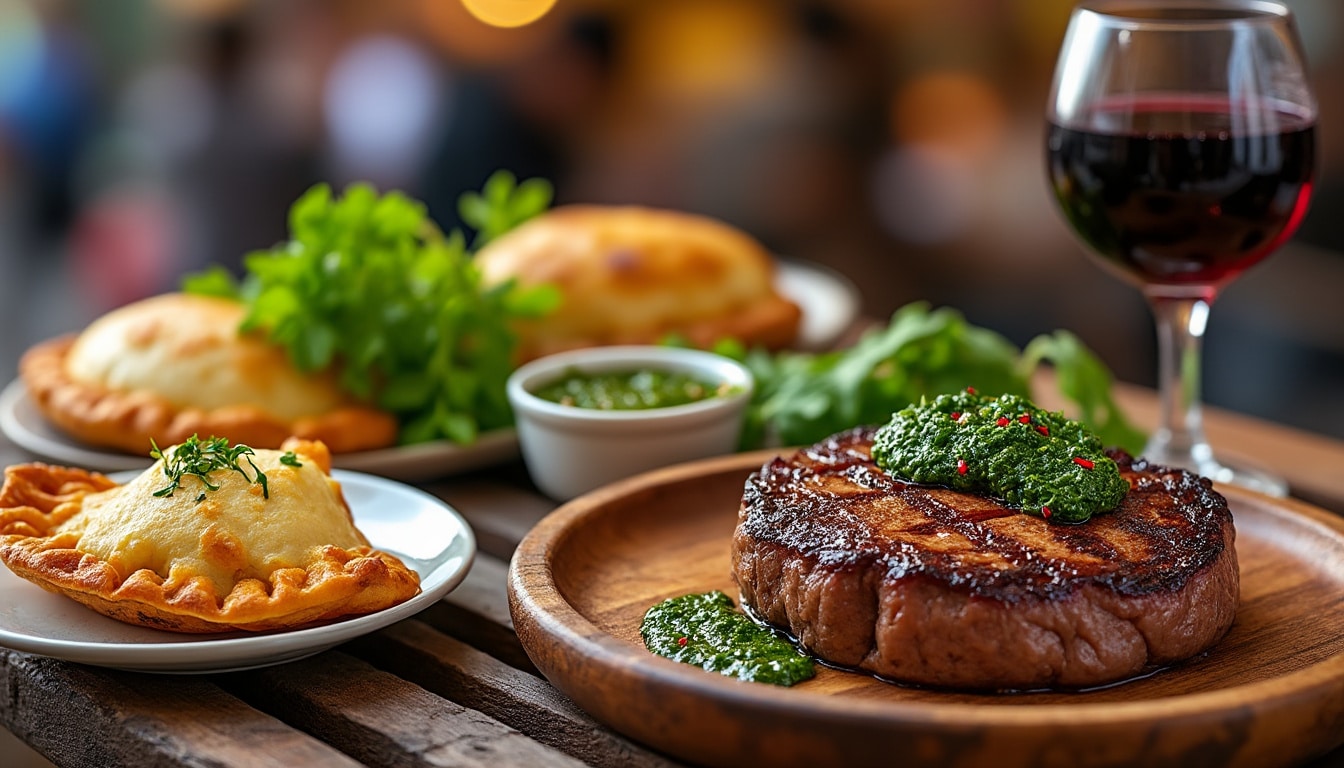Buenos Aires, the bustling capital of Argentina, is a vibrant confluence of cultures, flavors, and lifestyles. Its cuisine is a testament to this diversity, offering a wide array of world-renowned dishes that appeal to palates across the globe. From the charcoal-infused succulence of asado to the sweet allure of dulce de leche, the city is a culinary paradise waiting to be explored. Dive into the rich textures and tastes that define Buenos Aires, and discover why it continues to captivate food enthusiasts and cultural voyagers alike.
Asado: The Quintessential Argentine Barbecue Experience
In Buenos Aires, nothing exemplifies the local culinary art like Asado. This Argentine barbecue is more than just a meal; it’s a social tradition, a celebration of flavors that unites families and friends around a parrilla (grill). Imagine a variety of meats slow-cooked to perfection over an open flame, liberally seasoned with nothing more than a hint of salt, capturing the pure, unadulterated taste of the beef 🔥.
Asado reflects the nation’s cultural heritage, with influences ranging from Indigenous methods to Spanish and Italian culinary practices. Argentines take pride in the high quality of their beef, sourced from cattle roaming the Pampas. Popular cuts include vacio (flank steak), entraña (skirt steak), and tira de asado (flanken ribs). It’s not just the taste but the event itself that is significant, typically taking place over weekends or holidays, much like a family festival 🎉.
The atmosphere is enhanced with servings of provoleta (grilled provolone cheese), chimichurri (a garlic-parsley sauce), and salsa criolla (a mix of onions, tomatoes, and vinegar), offering balancing acidic and creamy notes to the rich meats. For the best Asado experiences, Buenos Aires has plenty of choices. La Cabrera in Palermo is renowned for its exceptional steaks, while Don Julio is a Michelin-starred gem that offers top-quality Argentinian beef 🥩.
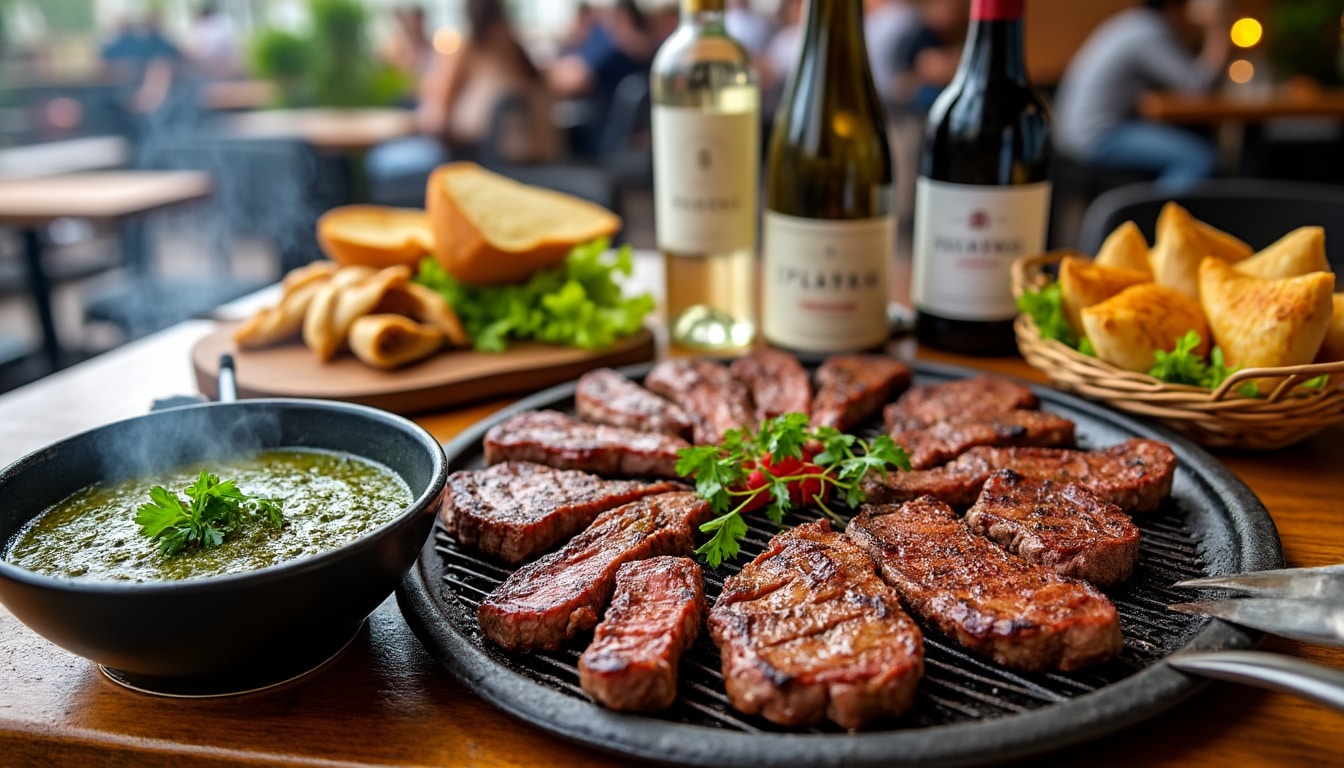
Classic Asado Cuts and Accompaniments
Each cut of meat in an Asado comes with its distinct texture and flavor profile. For instance, the vacio is known for its rich flavor and tenderness, while tira de asado delivers a juicy, fatty experience with every bite. Accompaniments often include rustic dishes that complement the meats. Choripan, a sandwich of sausage and chimichurri, is a popular starter for this meat feast.
Renowned for their charred perfection and flavorful sauces, Parrillas around Buenos Aires offer unparalleled heartiness and warmth, inviting guests to embrace the Argentine way – a communal blend of tradition, flavor, and unpretentious joy.
Empanadas: A Portable Slice of Argentine Life
No trip to Buenos Aires would be complete without savoring an empanada. These delightful pastry pockets are more than just snacks; they are a culinary tapestry reflecting Argentina’s melting pot of cultures. With origins in Galician and Moorish influences, Merienda time isn’t the same without these savory pastries 🥟.
Empanadas are available in a variety of fillings, each region in Argentina adding its local flare to this classic dish. In Buenos Aires, some popular fillings include beef, chicken, ham and cheese, and corn. The dough can be baked to a crisp golden hue or fried for a more indulgent treat, and they are often accompanied by a spicy chimichurri for dipping.
El Hornero in San Telmo is a favorite amongst locals for its unbeatable empanadas. An iconic culinary experience awaits, offering both traditional and contemporary takes on this beloved dish. You might even indulge in a cooking class at The Argentine Experience to learn the art of folding and filling these little pockets of joy.
- 🍗 Beef: The classic, featuring ground beef, onions, eggs, and olives.
- 🌽 Corn: A mix of sweet corn and creamy sauce.
- 🧀 Ham and Cheese: A melty, savory indulgence.
Empanadas are more than mere snacks. They represent the spirit of Buenos Aires – casual yet flavorful, and utterly irresistible. Whether enjoyed on the go or as part of a leisurely meal, these pastries capture the essence of Argentine street food culture.
Sweet Temptations: Exploring the World of Dulce de Leche
Sweet, rich, and creamy, dulce de leche is a staple in every Buenos Aires home. This caramel-like sauce, made from slowly heated sweetened milk, steals the spotlight in Argentine confectioneries. Used in pastries, cakes, and even ice creams, dulce de leche adds a decadent touch that can’t be missed in your culinary exploration 🍬.
Buenos Aires offers numerous opportunities to enjoy this beloved sweet. From classic pastries filled with dulce de leche to the iconic alfajores, the city is a haven for those with a sweet tooth. Alfajores, sandwich-like cookies, are particularly famous and come in various flavors, surrounded by chocolate, coconut, or simple sugar glaze.
While visible throughout the city, Café Tortoni, a historical café, is a must-visit for those looking to indulge in traditional Argentine sweets. Here, the exquisite taste of alfajores and the charm of Buenos Aires go hand in hand, creating an unforgettable experience.
Where to Savor Dulce de Leche
The sweet allure of dulce de leche isn’t limited to cafés. For a genuine Argentine dessert experience, head to a local “heladería” or ice cream parlor like Freddo to taste it in ice cream form. Rich, sweet, and wonderfully creamy, this dulce de leche variation is one of the many treats waiting to surprise you in Buenos Aires.
Modern Gastronomy: Buenos Aires’ Dining Revolution
While traditional dishes are the soul of Buenos Aires, the city does not shy away from modern culinary innovation. Over recent years, Buenos Aires has embraced a global dining scene, from sushi to haute cuisine, reflecting an evolving gastronomic identity. The city’s fusion offerings are redefining what it means to dine in Buenos Aires, providing visitors with a dynamic range of options 🍣.
Several top-tier locations contribute to this dynamic shift. El Pilar offers a delightful fusion of Argentine and contemporary tastes, featuring a diverse menu that surprises the palate. Los Perdidos, on the other hand, showcases modern Argentine cuisine with unique twists on classic dishes, presenting both a nod to tradition and a leap toward innovation.
Sushi garnered significant popularity as well, with chains like Sushi Club producing delectable rolls that combine fresh local ingredients with traditional Japanese techniques. The fusion of flavors creates an exciting blend that attracts food lovers from all corners of the globe.
The rise of modern gastronomy in Buenos Aires underscores the city’s cultural transformation, maintaining a delicate balance between honoring culinary roots while embracing the new. It’s a city where traditional meets contemporary, and the results are nothing short of superb.
The Social Hub: Cafés and Confectioneries of Buenos Aires
In Buenos Aires, cafés are integral to the social fabric of the city. They serve as gathering spots for leisurely afternoons, business meetings, or casual chats. Each café tells a story of the past while continuing to craft the future, offering a serene escape from the hustle and bustle outside ☕.
Legendary establishments like Café Tortoni preserve the French and Italian influences that have shaped Buenos Aires’ café culture. Founded in 1858, it remains a cherished venue for locals and visitors alike. Instantly recognizable, the charming ambiance and eclectic menu make it an essential stop for any traveler.
Nurturing the sweet tooths is also on the agenda of Buenos Aires’s vast array of confectioneries. Whether it’s indulging in a buttery medialuna (Argentine croissant) or sipping on rich hot chocolate, a visit to one of these establishments provides a delightful experience.
Beyond the delicacies, it’s the company and conversations that define the café culture of Buenos Aires. Embrace it by sitting back with a cup of coffee or a fresh maté, and watch the world go by, understanding why Buenos Aires is celebrated not just for its food, but its vibrant community spirit.
FAQ
- What are popular dishes to try in Buenos Aires aside from steak?: Buenos Aires offers a wide range of delicious dishes like empanadas, dulce de leche desserts, and milanesas.
- Is Buenos Aires suitable for vegetarians?: Yes, the city has embraced vegetarian and vegan options, with many restaurants offering plant-based meals.
- When is the best time to visit Buenos Aires for a culinary experience?: Buenos Aires is delightful all year round, though spring and autumn offer pleasant weather and vibrant cultural festivals.
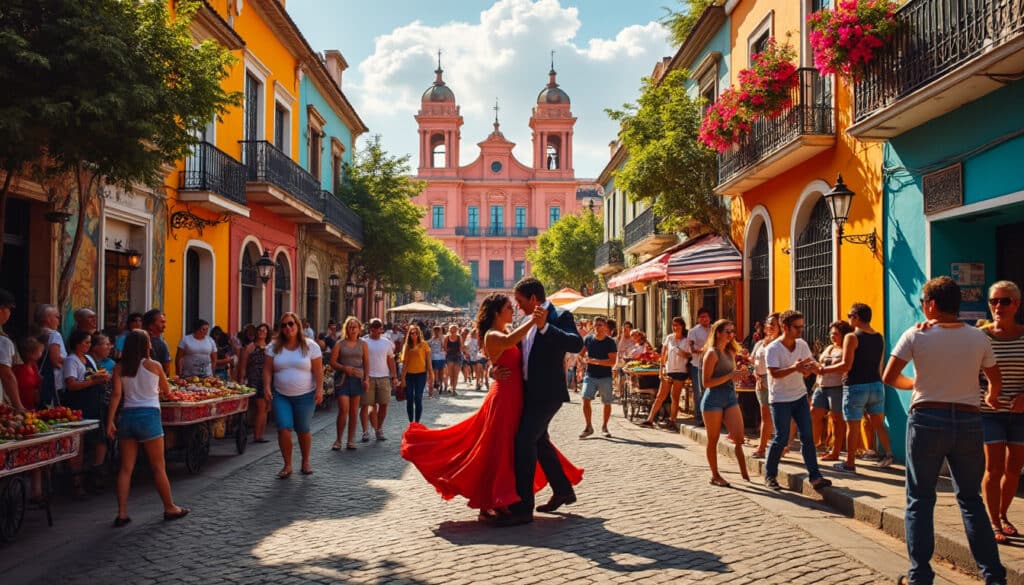
Culture & Local Life in Buenos Aires
Buenos Aires, often called the “Paris of South America,” is a city that beats to the rhythm of its unique culture, vibrant street life, and historic richness. Home to the passionate tango and deeply rooted traditions, it’s a metropolis where…
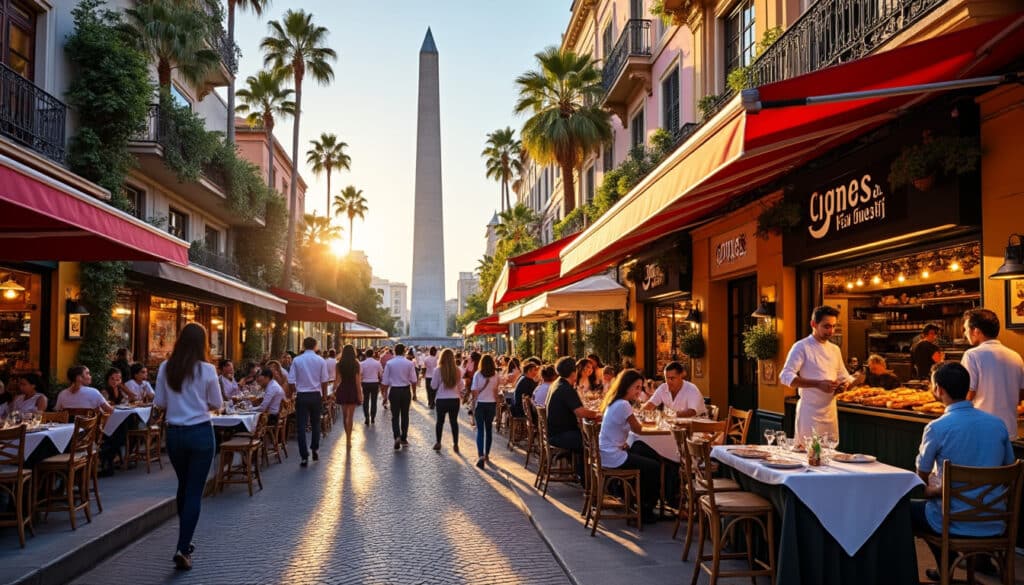
Best places to eat in Buenos Aires
Buenos Aires, a city renowned for its vibrant culture and passionate community, is equally famous for its diverse culinary landscape. Amidst the colorful neighborhoods and historic avenues, locals and visitors alike embark on gastronomic journeys that reflect the rich tapestry…

Languages spoken in Buenos Aires
Buenos Aires, the vibrant capital of Argentina, is a city renowned for its rich cultural tapestry and bustling city life. Among its myriad of cultural elements, the languages spoken play a pivotal role in shaping the city’s unique identity. From…
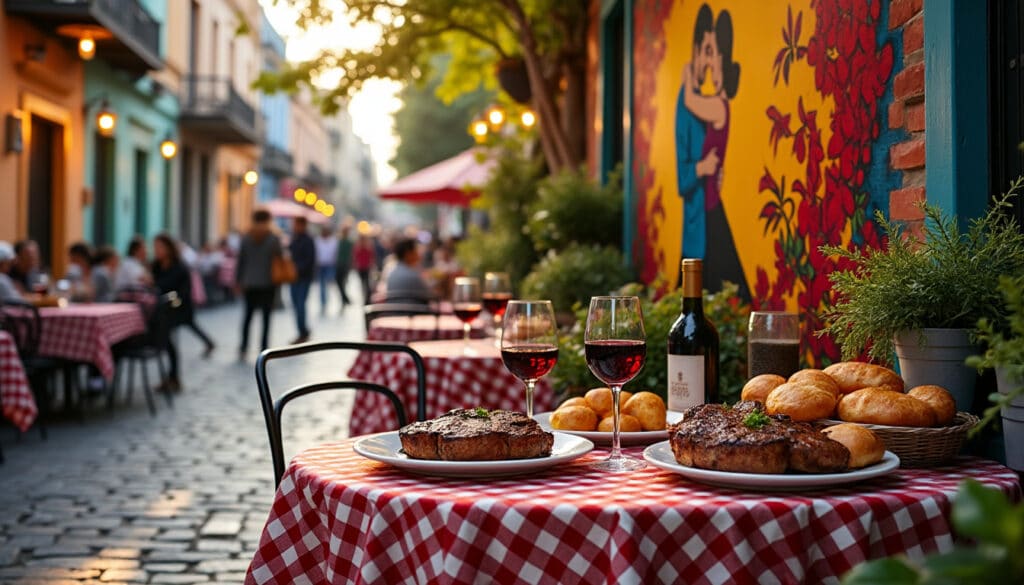
Buenos Aires, the bustling capital of Argentina, is a city that’s as alive at night as it is during the day. As any visitor to the city will quickly discover, the inhabitants, known as Porteños, have a unique rhythm to…
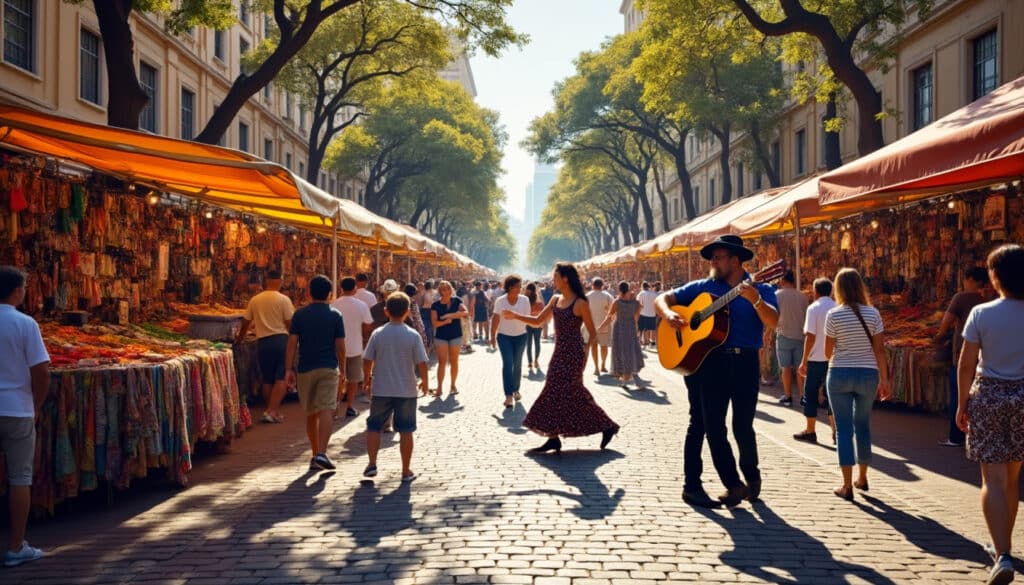
Souvenirs and shopping in Buenos Aires
Buenos Aires, the capital of Argentina, is not just a city; it’s a vibrant tapestry of cultures, history, and artistry. The experience of shopping here is as enriching as the treasures you bring back. From artisanal crafts and exquisite leather…

What do people eat in Buenos Aires?
Buenos Aires, often called the “Paris of South America,” is a city renowned for its vibrant culture, tango rhythms, and, importantly, its diverse and flavorful cuisine. The culinary scene in Buenos Aires is a reflection of its rich history and…

